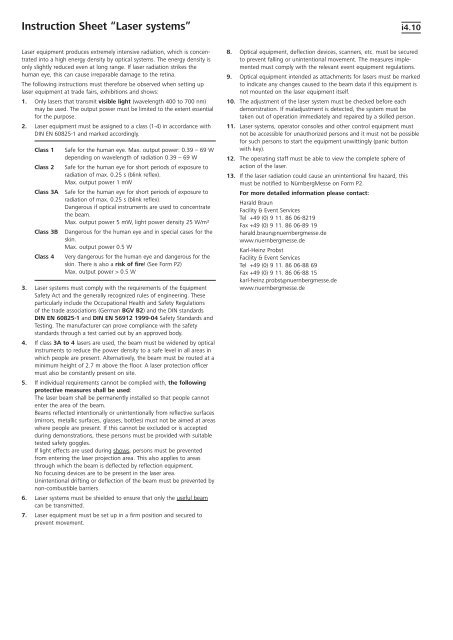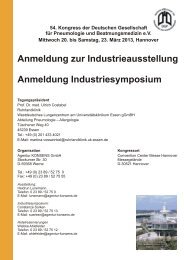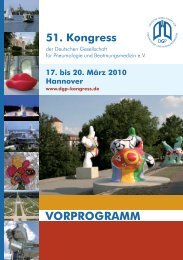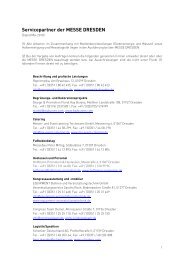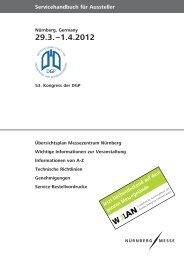Instruction Sheet - Agentur KONSENS
Instruction Sheet - Agentur KONSENS
Instruction Sheet - Agentur KONSENS
Create successful ePaper yourself
Turn your PDF publications into a flip-book with our unique Google optimized e-Paper software.
44<br />
<strong>Instruction</strong> <strong>Sheet</strong> “Laser systems” i4.10<br />
Laser equipment produces extremely intensive radiation, which is concentrated<br />
into a high energy density by optical systems. The energy density is<br />
only slightly reduced even at long range. If laser radiation strikes the<br />
human eye, this can cause irreparable damage to the retina.<br />
The following instructions must therefore be observed when setting up<br />
laser equipment at trade fairs, exhibitions and shows:<br />
1. Only lasers that transmit visible light (wavelength 400 to 700 nm)<br />
may be used. The output power must be limited to the extent essential<br />
for the purpose.<br />
2. Laser equipment must be assigned to a class (1-4) in accordance with<br />
DIN EN 60825-1 and marked accordingly.<br />
Class 1 Safe for the human eye. Max. output power: 0.39 – 69 W<br />
depending on wavelength of radiation 0.39 – 69 W<br />
Class 2 Safe for the human eye for short periods of exposure to<br />
radiation of max. 0.25 s (blink reflex).<br />
Max. output power 1 mW<br />
Class 3A Safe for the human eye for short periods of exposure to<br />
radiation of max. 0.25 s (blink reflex).<br />
Dangerous if optical instruments are used to concentrate<br />
the beam.<br />
Max. output power 5 mW, light power density 25 W/m²<br />
Class 3B Dangerous for the human eye and in special cases for the<br />
skin.<br />
Max. output power 0.5 W<br />
Class 4 Very dangerous for the human eye and dangerous for the<br />
skin. There is also a risk of fire! (See Form P2)<br />
Max. output power > 0.5 W<br />
3. Laser systems must comply with the requirements of the Equipment<br />
Safety Act and the generally recognized rules of engineering. These<br />
particularly include the Occupational Health and Safety Regulations<br />
of the trade associations (German BGV B2) and the DIN standards<br />
DIN EN 60825-1 and DIN EN 56912 1999-04 Safety Standards and<br />
Testing. The manufacturer can prove compliance with the safety<br />
standards through a test carried out by an approved body.<br />
4. If class 3A to 4 lasers are used, the beam must be widened by optical<br />
instruments to reduce the power density to a safe level in all areas in<br />
which people are present. Alternatively, the beam must be routed at a<br />
minimum height of 2.7 m above the floor. A laser protection officer<br />
must also be constantly present on site.<br />
5. If individual requirements cannot be complied with, the following<br />
protective measures shall be used:<br />
The laser beam shall be permanently installed so that people cannot<br />
enter the area of the beam.<br />
Beams reflected intentionally or unintentionally from reflective surfaces<br />
(mirrors, metallic surfaces, glasses, bottles) must not be aimed at areas<br />
where people are present. If this cannot be excluded or is accepted<br />
during demonstrations, these persons must be provided with suitable<br />
tested safety goggles.<br />
If light effects are used during shows, persons must be prevented<br />
from entering the laser projection area. This also applies to areas<br />
through which the beam is deflected by reflection equipment.<br />
No focusing devices are to be present in the laser area.<br />
Unintentional drifting or deflection of the beam must be prevented by<br />
non-combustible barriers.<br />
6. Laser systems must be shielded to ensure that only the useful beam<br />
can be transmitted.<br />
7. Laser equipment must be set up in a firm position and secured to<br />
prevent movement.<br />
44<br />
8. Optical equipment, deflection devices, scanners, etc. must be secured<br />
to prevent falling or unintentional movement. The measures implemented<br />
must comply with the relevant event equipment regulations.<br />
9. Optical equipment intended as attachments for lasers must be marked<br />
to indicate any changes caused to the beam data if this equipment is<br />
not mounted on the laser equipment itself.<br />
10. The adjustment of the laser system must be checked before each<br />
demonstration. If maladjustment is detected, the system must be<br />
taken out of operation immediately and repaired by a skilled person.<br />
11. Laser systems, operator consoles and other control equipment must<br />
not be accessible for unauthorized persons and it must not be possible<br />
for such persons to start the equipment unwittingly (panic button<br />
with key).<br />
12. The operating staff must be able to view the complete sphere of<br />
action of the laser.<br />
13. If the laser radiation could cause an unintentional fire hazard, this<br />
must be notified to NürnbergMesse on Form P2.<br />
For more detailed information please contact:<br />
Harald Braun<br />
Facility & Event Services<br />
Tel +49 (0) 9 11. 86 06-8219<br />
Fax +49 (0) 9 11. 86 06-89 19<br />
harald.braun@nuernbergmesse.de<br />
www.nuernbergmesse.de<br />
Karl-Heinz Probst<br />
Facility & Event Services<br />
Tel +49 (0) 9 11. 86 06-88 69<br />
Fax +49 (0) 9 11. 86 06-88 15<br />
karl-heinz.probst@nuernbergmesse.de<br />
www.nuernbergmesse.de


